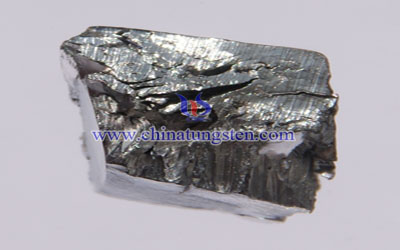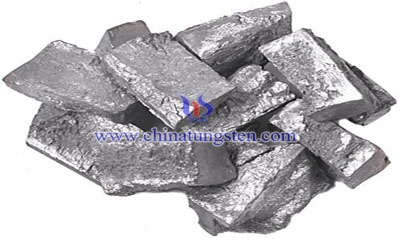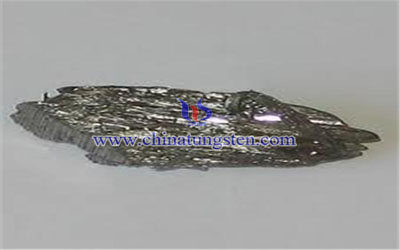Basic Knowledge About Terbium
- Details
- Category: Rare Earth News
- Published on Thursday, 14 March 2013 16:48
- Written by Yuri
- Hits: 2558
Terbium (Tb, atomic number 65) was discovered by Mosander in 1843. Terbium is found in cerite, gadolinite and other minerals along with other rare earths. It is also recovered from monazite in which it is present to the extent of 0.03%, from xenotime and from euxnite (a complex oxide containing 1% more of terbia). Terbium has been isolated only in recent years with the development of ion exchange techniques for separating the rare earth elements. As with other rare earth metals; terbium can be produced by reducing the anhydrous chloride or fluoride with calcium metal in a tatalum crucible. Calcium and tantalum impurities can be removed by vacuum re-melting. Other methods of isolation are also possible. Terbium is reasonably stable in air. It is a silver grey metal which is malleable, ductile and soft enough to be cut with a knife. Two crystal modifications exist with a transformation temperature of 1289 degrees Celsius. The oxide is a chocolate or dark maroon color.

Some known uses of Terbium are as follows:
Solid state devices use sodium terbium borate.
The oxide has potential application as an activator for green phosphors used in color television tubes.
In combination with Zr02 as a crystal stabilizer of fuel cells which operate at elevated temperatures.
Rare Earth Manufacturer & Supplier: Chinatungsten Online - http://www.chinatungsten.com
Tel.: 86 592 5129696; Fax: 86 592 5129797
Email: sales@chinatungsten.com
Tungsten News & Tungsten Prices, 3G Version: http://3g.chinatungsten.com
Tungsten News & Tungsten Prices, WML Version: http://m.chinatungsten.com
Basic Knowledge About Lutetium
- Details
- Category: Rare Earth News
- Published on Thursday, 14 March 2013 16:43
- Written by Yuri
- Hits: 2477
Lutetium (Lu, atomic number 71) – In 1907, Urbain described a process by which Marignac’s ytterbium (1879) could be separated into the two elements, ytterbium (neoytterbium) and lutetium. These elements were identical with “aldebaranium” and “cassiopeium”, independently discovered at this time. The spelling of the element was changed from lutecium to lutetium in 1949. Lutetium occurs in very small amounts in nearly all minerals containing yttrium and is present in monazite to the extent of about 0.003% which is commercial source. The pure metal has been isolated only in recent years and is one of the most difficult to prepare. It can be prepared by the reduction of the anhydrous LuCl3 or LuF3 by an alkaline earth metal. The metal is silvery white and relatively stable in air. 176Lu occurs naturally (2.6%) with 175 Lu (97.4%). It is radioactive with a half-life of about 3 x 10 10 years.

Some known uses for Lutetium are as follows:
Stable lutetium nuclides, which emit pure beta radiation after thermal neutron activation, can be used as catalysts in crackling, alkylation, hydrogenation and polymerization.
Single crystal scintillators
Rare Earth Manufacturer & Supplier: Chinatungsten Online - http://www.chinatungsten.com
Tel.: 86 592 5129696; Fax: 86 592 5129797
Email: sales@chinatungsten.com
Tungsten News & Tungsten Prices, 3G Version: http://3g.chinatungsten.com
Tungsten News & Tungsten Prices, WML Version: http://m.chinatungsten.com
Basic Knowledge About Gadolinium
- Details
- Category: Rare Earth News
- Published on Thursday, 14 March 2013 16:09
- Written by Yuri
- Hits: 2533
Gadolinium (Gd, atomic number 64) rare earth metal is obtained from the mineral gadolinite. Gadolinia, the oxide of gadolinium, was separated by Merignac in 1880 and Lecoq de Boisbaudran independently isolated it from Mosasander’s yttria in 1886. Gadolinium is found in several other minerals, including monazite and bastnasite. With the development of ion-exchange and solvent extraction techniques, the availability and the prices of gadolinium and the other rare earth metals have greatly improved. The metal can be prepared by the reduction of the anhydrous fluoride with metallic calcium. Gadolinium is silvery white, has a metallic luster and is malleable and ductile (like other related rare earth metals). At room temperature gadolinium crystallizes in the hexagonal, close packed alpha form. Upon heating to 1235 degrees Celsius, alpha gadolinium transforms into the beta form (which has a body centered cubic structure). The metal is relatively stable in dry air but tarnishes in moist air. It forms a loosely adhering oxide film which falls off and exposes more surface to oxidation. The metal reacts slowly with water and is soluble in dilute acid. Gadolinium has the highest thermal neutron capture cross-section of any known element (49,000 barns).

Some known uses for Gadolinium are as follows:
MRI tests- gadolinium changes the way water molecules react in your body when scanned allowing the contrast between healthy and non healthy tissue to be seen.
Microwaves- gadolinium yttrium garnets are used in microwave applications.
Color Television_ gadolinium compounds are used as phosphors in color televisions.
The unusual superconductive properties improve the workability and resistance of iron and chromium and related alloys to high temperatures and oxidation (as little as 1% gadolinium is needed).
Duplicating performance of amplifiers such as the maser- gadolinium ethyl sulfate ahs extremely low noise characteristics and may find use in duplicating the performance.
Magnetic component that can sense hot and cold- gadolinium metal is ferromagnetic. It is unique for its high magnetic movement and for its special Curie temperature (above which ferromagnetism vanishes) lying at room temperature. Therefore it can be used as a magnetic component that can sense hot and cold.
Rare Earth Manufacturer & Supplier: Chinatungsten Online - http://www.chinatungsten.com
Tel.: 86 592 5129696; Fax: 86 592 5129797
Email: sales@chinatungsten.com
Tungsten News & Tungsten Prices, 3G Version: http://3g.chinatungsten.com
Tungsten News & Tungsten Prices, WML Version: http://m.chinatungsten.com
Basic Knowledge About Holmium
- Details
- Category: Rare Earth News
- Published on Thursday, 14 March 2013 16:35
- Written by Yuri
- Hits: 2480
Holmium (Ho, atomic number 67).The special absorption bands of holmium were noticed in 1878 by the Swiss chemists Delafontaine and Soret, who announce the existence of an “Element X”. Cleve, of Sweden, later independently discovered the element while working on erbia earth. The element is name is therefore name after Cleve’s native city. Holmia, the yellow oxide, was prepared by Homberg in 1911. Holmium occurs in gadolinite, monazite and in other rare earth minerals. It has been isolated by the reduction of its anhydrous chloride or fluoride with calcium metal. Pure holmium has a metallic to bright silver luster. It is relatively soft and malleable, it is able to stay dry in room temperature, but it rapidly oxidizes in moist air and at elevated temperatures. Holmium metal has unusual magnetic properties. It has the highest magnetic moment of any known element in the periodic table. It has the greatest number of impaired electrons and impaired electrons are what give rise to magnetism. Therefore, Holmium has many uses in magnetic materials. Very few other uses have been found for the element. Like some other rare earths Holmium seems to have a low acute toxic rating.

Some known uses for Holmium are as follows:
Magnets
Ceramics
Lasers
Rare Earth Manufacturer & Supplier: Chinatungsten Online - http://www.chinatungsten.com
Tel.: 86 592 5129696; Fax: 86 592 5129797
Email: sales@chinatungsten.com
Tungsten News & Tungsten Prices, 3G Version: http://3g.chinatungsten.com
Tungsten News & Tungsten Prices, WML Version: http://m.chinatungsten.com
Basic Knowledge About Europium
- Details
- Category: Rare Earth News
- Published on Thursday, 14 March 2013 16:00
- Written by Yuri
- Hits: 2516
Europium (Eu, atomic number 63) was discovered in the form of spectral lines that were not accounted for by samarium or gadolinium concentrates in 1890 by Boisbaudran. The official discovery of europium is generally credited to Demarcay who separated the rare earth in reasonably pure form in 1901. The pure metal was not isolated until recent years. Europium is now prepared by mixing Eu203 with a 10% excess of lanthanum metal and heating the mixture in a tantalum crucible under high vacuum. The element is collected as a silvery white metallic deposit on the walls of the crucible. As with other rare earth metals (with the exception of lanthanum), europium ignites in air at about 150 to 180 degrees Celsius. Europium is about as hard as lead and is quite ductile. It is the most reactive of the rare earth metals, it quickly oxidizes in air. It resembles calcium in its reaction to water. Bastnasite and monazite are the principal ores containing europium. Europium has been identified spectroscopy in the sun and certain stars.

Some known uses for Europium are as follows:
Television screens- europium oxide is now widely used as a phosphor activator and europium activated yttrium vanadate.
Laser material- europium doped plastic is used as laser material.
Ceramics
Nuclear applications.
Rare Earth Manufacturer & Supplier: Chinatungsten Online - http://www.chinatungsten.com
Tel.: 86 592 5129696; Fax: 86 592 5129797
Email: sales@chinatungsten.com
Tungsten News & Tungsten Prices, 3G Version: http://3g.chinatungsten.com
Tungsten News & Tungsten Prices, WML Version: http://m.chinatungsten.com





 sales@chinatungsten.com
sales@chinatungsten.com